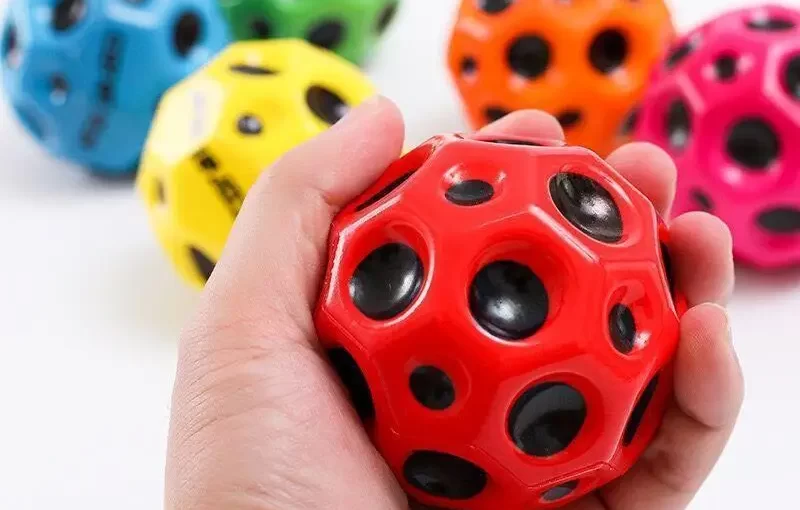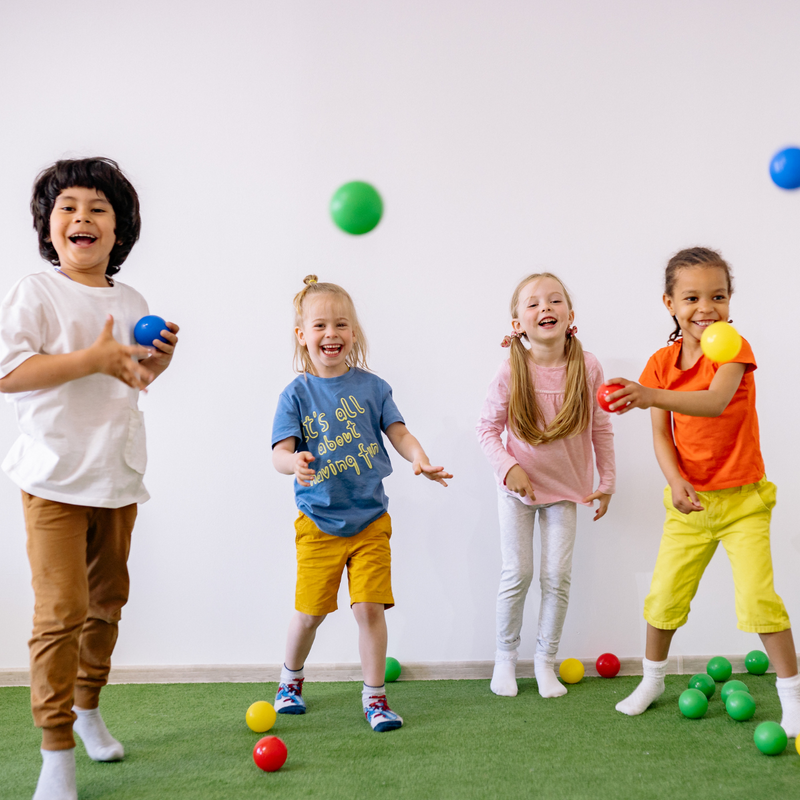Introduction to the Importance of Ball Play in Toddler Development
Balls are timeless toys that every child loves. Ball sensory activities for toddlers spur endless joy and are key to toddler development. Through ball play, toddlers engage multiple senses and refine vital skills. Here’s why ball play is essential:
Boosts Sensory Development
Balls with different textures excite a toddler’s sense of touch. Bright colors and sounds from balls sharpen their sight and hearing. These ball sensory activities for toddlers build their sensory experiences.
Enhances Motor Skills
Rolling, throwing, and catching balls help improve toddlers’ fine and gross motor skills. Toddlers learn control and coordination, crucial for their physical growth.
Encourages Cognitive Growth
Simple games like ‘ball hide and seek’ boost cognitive development. Toddlers learn about object permanence, cause and effect, and problem-solving.
Promotes Social Interaction
Ball play teaches toddlers to share, take turns, and interact with peers. These skills are important for their social development.
Fosters Independence and Confidence
Toddlers gain independence by playing with balls on their own. As they master new skills, their confidence soars.
In short, ball play is important for toddlers’ overall growth. It combines fun with learning, making it a favorite for both kids and parents. Let’s explore a variety of ball activities that can enrich toddlers’ sensory experiences and developmental milestones.
Ball Activities for Sensory Exploration
When choosing sensory ball activities for toddlers, variety is key. Different balls can stimulate various senses and enhance learning.
Balls of Different Sizes, Shapes, and Textures
Offering a mix of ball sizes, shapes, and textures invites toddlers to explore and discover. Small soft balls are easy to grasp, while larger ones encourage whole-body movement.
- Provide lightweight, small balls for easy grabbing.
- Introduce textured balls to stimulate touch.
- Include larger, heavier balls to build motor skills.
Through play, toddlers learn how different balls feel and behave, which is beneficial for sensory development.
Light-up Balls and Sound-making Balls
Balls that light up or make sounds add an auditory and visual aspect to play.
- Use balls with lights to catch toddlers’ attention.
- Sound-making balls can help in recognizing different noises.
These sensory balls are not just fun but also support auditory and visual processing skills.
Engaging Babies with Sensory Ball Play
Introducing babies to ball play is essential for their development. A simple ball can become a powerful tool to explore the senses and develop motor skills.
Exploring Ball Textures and Movements
To captivate a baby’s curiosity, offer balls with various textures and movements. Smooth, bumpy, and squishy textures fascinate their touch. Encourage them to roll, squeeze, and bounce balls for a playful sensory feast.
- Choose soft, textured balls safe for mouthing.
- Dynamic balls that bounce unpredictably spark visual tracking.
- Demonstrate rolling balls to foster gross motor skills.
Sensory Ball Games for Improved Motor Skills and Coordination
Help babies enhance their motor skills and coordination with simple ball games.
- Gently roll a ball towards your baby to prompt reaching and grasping.
- Support them in passing a ball from one hand to the other.
- Use larger balls to encourage babies to push and crawl.
These ball sensory activities for toddlers bolster their physical growth while they grasp, track, and follow the balls. Keep playtimes short and engaging to match a baby’s attention span.
Ball Play for Toddlers’ Development
Encouraging toddlers to engage in ball play offers numerous developmental benefits. Through various ball sensory activities for toddlers, they can enhance their eye-hand and foot coordination, improve balance, and develop a foundation for future physical activities.
Eye-Hand/Foot Coordination and Balance Improvement Activities
Introduce simple ball handling practices to help toddlers develop coordination:
- Roll a ball and ask them to catch or stop it with their feet.
- Toss a soft ball and guide them to catch it with their hands.
- Prop up cushions and encourage toddlers to navigate around them while rolling a ball.
These activities assist in honing toddlers’ coordination skills and balance, which are vital for their physical development.
Creative Games to Enhance Toddlers’ Sensory Experience
Incorporating creativity into ball games can significantly enhance toddlers’ sensory experience:
- Use balls with different textures and encourage toddlers to describe what they feel.
- Fill clear plastic balls with colorful items to capture their visual attention.
- Create obstacle courses with balls that require toddlers to crawl over, under, and around various objects.
Such creative play not only stimulates toddlers’ senses but also nurtures their imagination and problem-solving skills.
Ball Games to Boost Toddlers’ Attention and Following Directions
Enhancing a toddler’s ability to pay attention and follow directions can be fun with balls. Ball sensory activities for toddlers are not only engaging but also educational.
Simple Throwing and Catching Techniques
Start with basic throwing and catching to improve coordination:
- Use soft, lightweight balls for easy handling.
- Stand close to your toddler and gently toss the ball.
- Encourage them to throw the ball back to you.
This back-and-forth play boosts toddlers’ hand-eye coordination and helps them learn to follow the trajectory of the ball.
Incorporating Balls into Learning Activities
Balls can be a tool for learning as well:
- Turn taking: Have toddlers pass a ball in a circle, teaching them patience and cooperation.
- Colors and counting: Use balls of different colors and sizes, asking toddlers to identify or count them as they play.
- Following directions: Give simple instructions like ‘kick the ball to the tree’ to practice listening and comprehension.
Involving ball play in learning activities keeps toddlers engaged while teaching valuable cognitive skills.
Playtime Ideas for Indoor and Outdoor Ball Activities
Ball play isn’t just for sunny days or spacious backyards. With a little creativity, you can turn any indoor space into the perfect setting for ball sensory activities for toddlers. Let’s explore some playtime ideas that can be adapted for both indoor and outdoor fun.
Ball Hide and Seek and Other Interactive Games
Interactive games that incorporate balls are fantastic for both indoor and outdoor play. Here are some ideas to keep your toddler active and entertained:
- Play ‘Ball Hide and Seek’ by hiding a ball and encouraging your toddler to find it.
- Invent a game of ‘Roll and Chase’ where you roll the ball away from your toddler, and they chase after it.
- Create a mini bowling set-up with empty bottles as pins and a soft ball to knock them down.
These ball games can spur your toddler’s movement, thinking skills, and enjoyment.
Safe Play Tips and Supervision for Toddlers
Safety always comes first during ball play. Follow these tips to keep your little one secure:
- Always keep a watchful eye on your toddler during playtime.
- Choose balls that are large enough to not be a choking hazard.
- Remove sharp objects and create a soft landing area with rugs or play mats.
- Teach your toddler not to throw balls towards people or breakable items.
With these tips, you’ll ensure a safe environment for your toddler to enjoy the many benefits of ball play.
Advancing to More Complex Ball Games with Preschoolers
As children grow, their play becomes more complex. Preschoolers are ready for ball games that teach teamwork and rules.
Structured Games that Promote Teamwork and Learning
Introduce games that encourage preschoolers to work together. Simple team games like ‘pass the ball’ teach cooperation. Try ‘monkey in the middle’ to hone reflexes and teamwork. Use balls in counting games to combine learning with play.
Adapting Ball Activities as Toddlers Grow
Adapt ball games as toddlers turn into preschoolers. Size up balls for throwing and catching skills. Modify ‘hide and seek’ to make it more complex for older kids. Include games that require more steps and rules for cognitive challenge.
Encouraging Continued Ball Play Beyond the Toddler Years
As children grow, their interest in ball play can evolve into a passion for sports or recreational activities. It’s beneficial to encourage this transition, as it promotes ongoing physical activity and skill development. Here are ways to foster a lasting love for ball play.
Community Leagues and Alternative Ball Sport Suggestions
Encouraging your child to join community leagues can be a great way to nurture their interest in ball sports. Look for local soccer, basketball, or baseball teams that accept children at various skill levels. For kids not drawn to traditional team sports, consider alternatives like:
- Dodgeball leagues, which can be less structured and equally fun.
- Kickball, which combines elements of soccer and baseball.
- Ultimate frisbee, for those who enjoy a mix of running and coordination.
Remember, the goal is to keep it fun and aligned with your child’s interests.
The Role of Balls in Lifelong Physical Activity
Ball activities don’t just equip kids with specific sports skills; they are also foundational for lifelong physical fitness. Whether it’s a casual game of catch or participating in organized sports, these activities help establish:
- Regular exercise habits.
- Hand-eye coordination.
- Teamwork and social skills.
- A healthy outlet for stress relief.
Keep the emphasis on enjoyment and personal growth, and you set the stage for a lifetime of healthy, active living.



